
11 minute read
WINTER PARADISE
As the name of the region suggests -‘Piedmont’, ‘at the foot of the mountains’ -, the area’s allure and winter attractions are inextricably linked to its mountains.
Some of the highest peaks in Europe, snow, unspoilt landscapes and breathtaking views. A combination that makes Piedmont the perfect region for a winter holiday. This doesn’t just apply to Turin, where in between a cultural break or a moment’s shopping you can indulge in a rejuvenating break with a cup of hot chocolate, but also the string of ski villages located only a two-hour drive from the city. As the name of the region suggests (‘Piedmont’, ‘at the foot of the mountains’), the area’s allure and winter attractions are inextricably linked to its mountains.
Advertisement
THE ‘VIA LATTEA’, A PARADISE OF WINTER SPORTS
When visiting Piedmont, you can’t think about its mountains without immediately reflecting on the ‘Via Lattea’ (or ‘Milky Way’), the largest ski area in western Italy that extends from Sauze d’Oulx (Salice d’Ulzio in Italian) to the French town of Montgenèvre. This includes the towns of Sestriere, San
Sicario, Clavière, Cesana
Torinese and Pragelato, as far as the neighbouring French border. A favourite hangout of the Torinese for a weekend dedicated to sport and relaxation, a charming outof-town destination for tourists who want to spend a few days in the open air either before or after visiting Turin, and a paradise for winter sports, this must-visit area offers world-class facilities. These include more than 400km of slopes dedicated to the most diverse sports including Alpine skiing, freestyle skiing, Skeleton, Nordic skiing, Bobsleigh, sleighing and Biathlon. However, the turning point came when the city played host to the 2006 Winter Olympics. As a result of the winter games, this area of the Alps, now known as the ‘Olympic Valleys’, became one of the most sought-after tourist destinations in the world, renowned for its offer of entertainment and activities. So how do you choose where to spend the weekend? It’s simple, and based on the motto ‘tell me what sport you

love and I’ll tell you which destination best suits your needs’. This is a detail that should not be underestimated by those who are paralyzed by choice. Multi-resort or season ski passes allow you to move freely from one resort in the area to another without paying additional fees (www. vialattea.it). These include Pragelato, where two dedicated slopes allow people of all ages and ability levels to indulge in sleighing and Bobsleighing, semi-flat areas like in Clavière, where you can try your hand at cross-country skiing or snowshoeing, valleys boasting the area’s steepest ski slopes – from Cesana, located at an altitude of 1,350 meters, to Cima Motta in Sestriere (2,800 meters). The latter are a delight for expert skiers and snowboarders in search of an adrenaline-filled experience. The area’s gentle slopes also make it an ideal destination for those who have decided to embark on their snow christening. Each resort offers top-notch schools specializing in skiing, snowboarding, sleighing, bobsleighing and freestyle lessons with qualified instructors and confidence-boosting slopes offering beginners a safe,
gentle introduction to snow sports. When it comes to a great ski weekend, having the right gear is key. If you don’t have your own equipment, you can either purchase it from one of the numerous sports shops lining the main streets of each town, or hire it on-site for one or two days. There’s also good news for iceskating enthusiasts. In the shadow of the high towers dominating the skyline of Sestriere, developed in the 1930s by FIAT founder Gianni Agnelli as a holiday resort for FIAT’s factory workers, you can skate from dawn till dusk at the
Emanuele Nasi Ice Stadium
(T: 0122 755444). After an active day on the slopes, indulge in a moment’s relaxation at one of the local Spas. Almost all hotels have jacuzzis, indoor swimming pools, saunas and Turkish baths that combine the beneficial effects of hydrotherapy with a relaxing Alpine ambience. One such example is the Hotel La Torre in Sauze d’Oulx, which offers outside guests the option of accessing its Spa area, where they can enjoy massages and ad hoc treatments (www. grandhotellatorre.it).
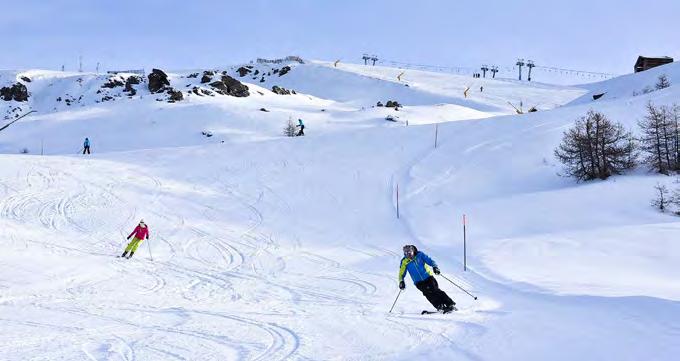
Chalet Il Capricorno
CHALET DE CHARME, FOR LOVERS OF TASTE
Thanks to its stunning scenery, exquisite cuisine and burgeoning cultural scene, it is not surprising that the region of Piedmont was named one of the Italian regions best-loved by international visitors in 2018 by ‘Lonely Planet’, one of the world’s biggest guide book publishers. One of the reasons for its success is its wealth of local gastronomic offerings, a great way to recharge your batteries between one downhill run and another, or as an ‘après ski’ treat at the end of the day. Lovers of good food in search of a break – or even a few days’ retreat – in a charming location at the edge of a wood that can only be accessed on skis or a snowmobile will find what they’re looking for at Chalet Il Capricorno. This 4-star hotel resembling a mountain chalet, directly overlooking the slopes of Sauze d’Oulx, has only eight rooms, and a gourmet menu featuring a combination of local flavours and seasonal

ingredients, served in a welcoming stone and wood setting (www.chaletilcapricorno. it). In ski resorts, a cocktail, known as an ‘après ski’, is a great way to relax and toast your day on the pistes. A favourite haunt of locals and visitors in search of a relaxing break after a long day’s skiing is Chalet Raggio di Sole. Located in the area of Sestriere’s amphitheatre, it’s a great place to enjoy a platter of charcuterie and local cheeses accompanied by a good glass of wine (official Facebook: @raggiodi. solesestriere). Always in Sestriere, Last Tango Grill Restaurant, one of the town’s oldest restaurants, delights diners’ palates both at lunch and dinner with a selection of Alpine specialties, including cured wild game like Deer Bresaola, Lamb Speck, Goose salami, Wild Boar Ham with Caramelized Onions or traditional hot dishes, that can be savoured in the locale’s warm, cozy surroundings enhanced by an indoor fireplace (www.lasttango.it). Les Icles is an intimate familyrun restaurant, located in Cesana Torinese, which offers diners hearty home-cooked cuisine comprising freshly sourced seasonal vegetables, Piedmont Fassona beef dishes, and homemade pasta and desserts made with organic flour. An absolute must for foodies in search of authentic old-world Piedmontese flavours (www.lesicles.it).

Chalet Raggio di Sole
Top destinations around Piedmont

Avant-garde wineries, a legacy of world-class cuisine and marvelous landscapes. All of these things have earned the areas of the Langhe, Roero and Monferrato UNESCO World Heritage status, resulting in an elite tourist destination.
This is UNESCO’s official reason for adding the wine-growing regions of the Langhe-
Roero and Monferrato
to its world heritage list in 2014. “An exceptional living testimony to the historical tradition of grape growing and winemaking processes, of a social context, and a rural economy based on viticulture. The vineyards of the LangheRoero and Monferrato are an outstanding example of man’s interaction with his natural surroundings.” This area is protected as a ‘cultural heritage’ which is symbolic, because man has managed to shape it, giving it the unique characteristics that it boasts today. In this area, the vineyards of several of the world’s most famous wines, including Barolo, Barbaresco, Asti Spumante and Barbera, stretch as far as the eye can see, in a display of changing colours and softly rolling hills. Although geographically the Langhe, Roero and Monferrato are neighbouring regions, they all have different morphologies, and cultural characteristics. The region’s varied landscape provides fertile soil for an impressive array of local specialties: from superlative wine, to the prized white truffles of Alba, porcini mushrooms and IGP hazelnuts. Located just an hour’s drive from Turin, these regions can be accessed by car (several of the larger centres can also be reached by train). Other options include one of the many organized wine and tasting tours on offer.
THE LANGHE
The Langhe are situated between the Tanaro River and Liguria, between the provinces of Asti and Cuneo. Particularly noteworthy among the area’s many tourist attractions are its numerous castles, including that of Grinzane Cavour. Built in the 13th century and currently home to the headquarters of the ‘Cavour Regional Enoteca’, the castle, in addition to stocking several of the region’s finest Doc and Docg wines, also hosts the interesting Langhe Museum (www.castellogrinzane.com). Other must-sees include the Castle of Barolo and its surrounding town, which gives its name to the most famous Italian red wine and is thought to date back to mediaeval times. The town is home to WiMu, a unique wine museum that takes visitors on an immersive journey through the history of viticulture via light, film and installations. The museum is set over three floors of the village’s stunning medieval castle, and the tour includes a visit to the building’s panoramic terrace and its ancient wine
La Morra, medieval village castle

Grinzane Cavour castle and village
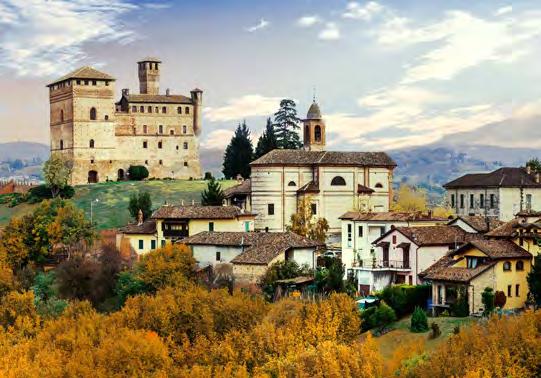
ZLEOKS/ SHUTTERSTOCK.COM ©
cellars (www.wimubarolo.it). After visiting the museum in Barolo, stop in the village of La Morra, better known as ‘the terrace of the Langhe’ thanks to its spectacular views, and head to Massimo Camia’s starred restaurant for a fabulous gourmet meal (www.massimocamia.it). In addition to other specialties, the area is renowned for its famous three-lobed hazelnut, boasting ‘Protected Geographical Indication’ status and used to make various sweet treats. If you want to purchase these tantalizing specialties and see how they’re made, visit Giovanni Cogno’s artisanal workshop (www.giovannicogno.it). Lastly, an absolute ‘must’ for lovers of medieval history and architecture is a visit to the Castle of Serralunga d’Alba, a beautifully preserved Gothic stronghold (www. castellodiserralunga.it). After the long walk up to the castle, take a break and treat yourself to a delicious gourmet meal at the Da Guido restaurant located in the nature reserve of Fontanafredda (www.guidoristorante.it).
Eco Museum - infernot
MONFERRATO
Stretching southwards, as far as the foot of the Ligurian Appenines, the Monferrato area occupies a fertile tract of terrain between the provinces of Alessandria and Asti. In addition to numerous historic, cultural and outdoor activities, Monferrato is renowned for its gastronomic specialties. Nature, culture, art and religion combine in a walk that takes visitors on a journey to discover the Nature Park of the Sacro Monte di Crea, in the province of Alessandria, a real feat of architectural design that encompasses Mount Crea and its sanctuary, which in turn, is a UNESCO World Heritage site. If you prefer a historical visit to an excursion, don’t miss the Eco Museum of ‘Pietra da Cantone’ – a type of sandstone only found in this area – in Cella Monte. For some years now, the museum has undertaken the arduous but worthwhile task of taking an inventory of the ‘infernot’ in the area. ’Infernot’ are dark, airless underground spaces, carved out in stone, located beneath houses and cellars
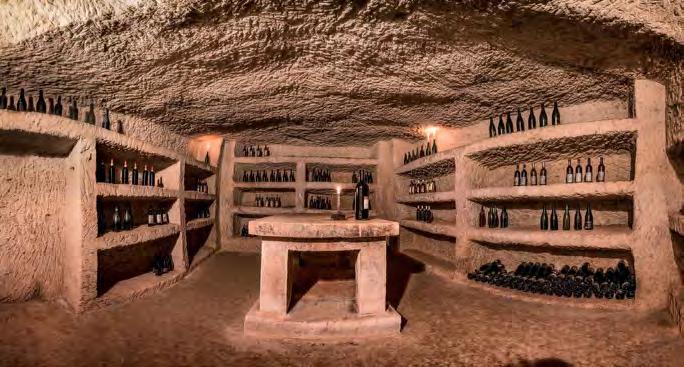
that, in some instances, are real underground tunnels. These works of arts, carved and modeled by artists, were either used to store bottles of wine, or as pantries, because the temperature inside them remains constant. Several of these old ‘infernot’ are open for public viewing, especially during the ‘vendemmia’ (grape harvest) or on special occasions (www. ecomuseopietracantoni.it). Although the majority of local wines are red and full-bodied, like Barbera, Grignolino and Freisa, you’ll also find a good selection of whites, including Moscato. An absolute ‘must’ for wine connoisseurs visiting the area is the Enoteca Regionale di Vignale Monferrato. Located in a magnificent 17th century ‘palazzo’, the Enoteca is a great place to taste and purchase some of the area’s best local wines (www. enotecadelmonferrato.it).
Castle of Govone

S74/ SHUTTERSTOCK.COM ©
ROERO
The Roero area is situated in the northeastern part of the province of Cuneo and is renowned for its
enogastronomic and
cultural offerings. Among its castles, the Castle of Govone was formerly one of the royal residences of the House of Savoy (www. castellorealedigovone.it). Located just a short distance from Alba, the Castle of Monticello is one of the most imposing and bestpreserved medieval buildings (www.roerodimonticello.it). Experience what it feels like to be a prince or princess for one night and stay at the Castle of Guarene, an important stopover on the Piedmontese Baroque itinerary which also hosts a hotel belonging to the Relais&Châteaux chain (www. castellodiguarene.com). Only a few kilometers from Bra, a trip to the architectural complex of the Agenzia di Pollenzo is well worth your time. Built in 1833, it now hosts the first University of
Gastronomic Sciences in
the world. This university was founded and promoted by the international Slow Food association, which studies, protects and disseminates the agricultural and enogastromic traditions of countries worldwide (www. agenziadipollenzo.com).
Castle of Guarene


[ WELCOME TO ITALIA ] Dream experiences
To discover the beauties of the city or to try out special experiences, Welcome to Italia offers you some unmissable opportunities. Choose whether to take part in exclusive city tours or book the experience you’ve been dreaming: www.welcometoitalia.com
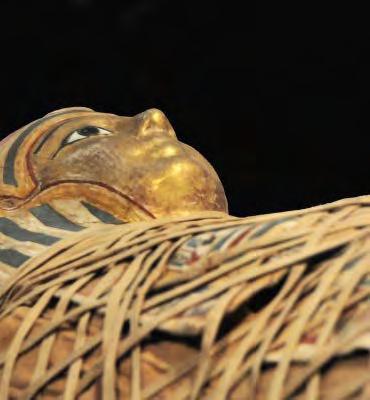
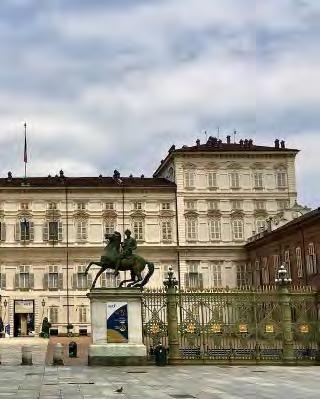
EGYPTIAN MUSEUM GUIDED TOUR
A journey in time and space through the second most important museum in the world for the study of the Ancient Egypt.
CLICK & BUY
ROYAL PALACE GUIDED TOUR
Explore with your guide the halls and rooms where the Italian royal family used to live. You will end your visit in the baroque Chapel of the Holy Shroud.








